bark_tokenize_input函数
- bark是没有语言控制选项的,但是官方的版本无法运行中文
- bark_tokenize_input会调用bert_tokenize函数,bark_tokenize_input函数对中文分词失效,也就是导致不支持中文的原因。
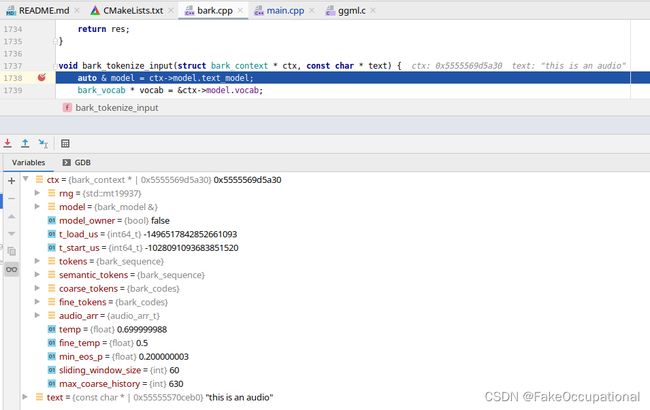
void bark_tokenize_input(struct bark_context * ctx, const char * text) {
auto & model = ctx->model.text_model;
bark_vocab * vocab = &ctx->model.vocab;
int32_t block_size = model.hparams.block_size;
int32_t max_ctx_size = std::min(block_size, 256);
int32_t n_tokens;
bark_sequence tokens(max_ctx_size);
bert_tokenize(vocab, text, tokens.data(), &n_tokens, max_ctx_size);
for (int i = 0; i < (int) tokens.size(); i++)
tokens[i] += TEXT_ENCODING_OFFSET;
if (n_tokens < max_ctx_size) {
for (int i = n_tokens; i < max_ctx_size; i++)
tokens[i] = TEXT_PAD_TOKEN;
} else if (n_tokens > max_ctx_size) {
fprintf(stderr, "%s: input sequence is too long (%d > 256), truncating sequence", __func__, n_tokens);
}
tokens.resize(max_ctx_size);
// semantic history
for (int i = 0; i < 256; i++)
tokens.push_back(SEMANTIC_PAD_TOKEN);
tokens.push_back(SEMANTIC_INFER_TOKEN);
assert(tokens.size() == 256 + 256 + 1);
ctx->tokens = tokens;
printf("%s: prompt: '%s'\n", __func__, text);
printf("%s: number of tokens in prompt = %zu, first 8 tokens: ", __func__, ctx->tokens.size());
for (int i = 0; i < std::min(8, (int) ctx->tokens.size()); i++) {
printf("%d ", ctx->tokens[i]);
}
printf("\n");
}
单词表对象



- 对象创建自vocab.txt
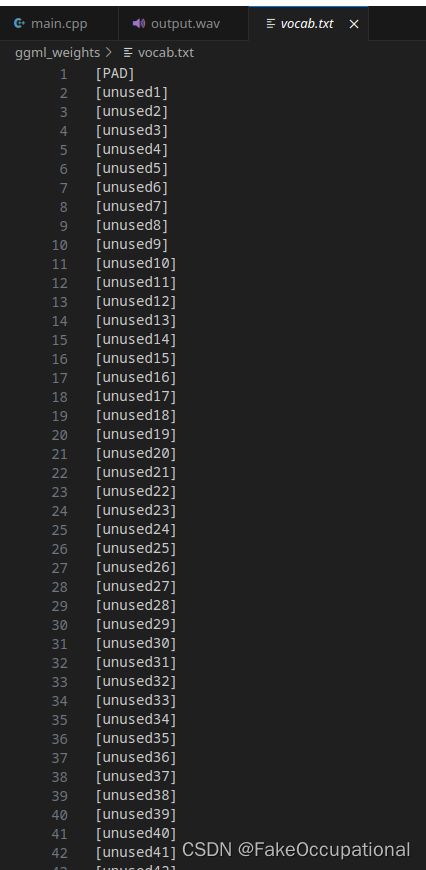
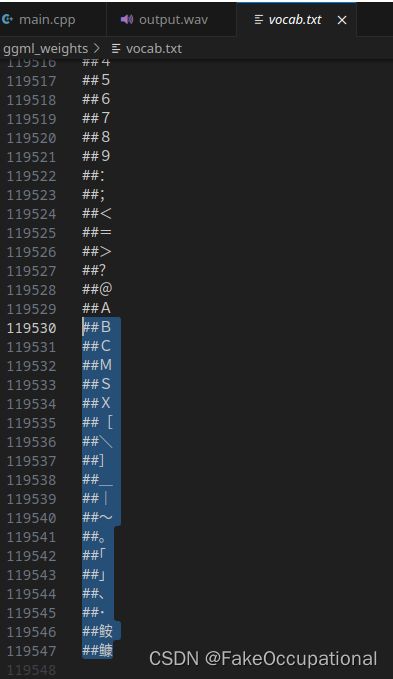
上一步完成后还会进行wordpiece处理
for (const auto &word : words) {
if (word.size() == 0)
continue;
std::string prefix = "";
int i = 0;
int n = word.size();
loop:
while (i < n) {
if (t >= n_max_tokens - 1)
break;
int j = n;
while (j > i) {
auto it = token_map->find(prefix + word.substr(i, j - i));
if (it != token_map->end()) {
tokens[t++] = it->second;
i = j;
prefix = "##";
goto loop;
}
--j;
}
if (j == i) {
fprintf(stderr, "%s: unknown token '%s'\n", __func__, word.substr(i, 1).data());
prefix = "##";
++i;
}
}
}
}
bert_tokenize函数
- bert_tokenize函数会将句子tockenlize到ctx中的tokens对象。
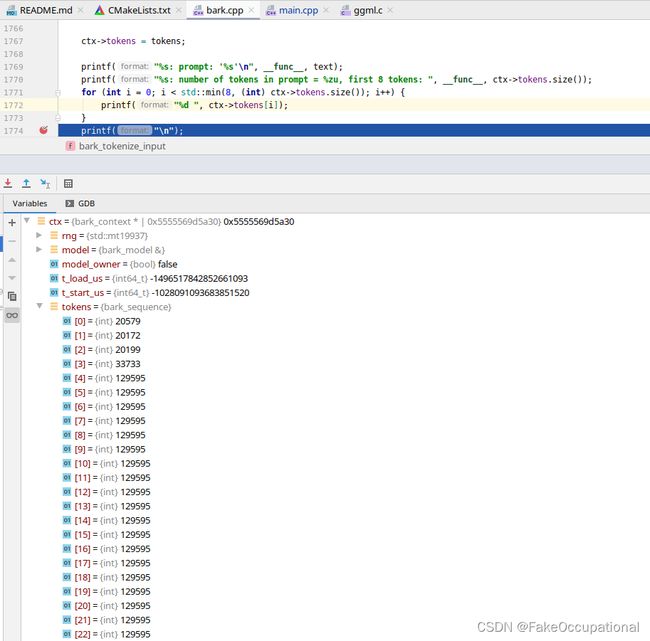
void bert_tokenize(
const bark_vocab * vocab,
const char * text,
int32_t * tokens,
int32_t * n_tokens,
int32_t n_max_tokens) {
std::string str = text;
std::vector words;
int32_t t = 0;
auto * token_map = &vocab->token_to_id;
// split the text into words
{
str = strip_accents(text);
std::string pat = R"([[:punct:]]|[[:alpha:]]+|[[:digit:]]+)";
std::regex re(pat);
std::smatch m;
while (std::regex_search(str, m, re)) {
for (std::string x : m)
words.push_back(x);
str = m.suffix();
}
}
// apply wordpiece
for (const auto &word : words) {
if (word.size() == 0)
continue;
std::string prefix = "";
int i = 0;
int n = word.size();
loop:
while (i < n) {
if (t >= n_max_tokens - 1)
break;
int j = n;
while (j > i) {
auto it = token_map->find(prefix + word.substr(i, j - i));
if (it != token_map->end()) {
tokens[t++] = it->second;
i = j;
prefix = "##";
goto loop;
}
--j;
}
if (j == i) {
fprintf(stderr, "%s: unknown token '%s'\n", __func__, word.substr(i, 1).data());
prefix = "##";
++i;
}
}
}
*n_tokens = t;
}
将文本分割成单词
- 将文本分割成单词的部分使用了如下的正则表达式,其无法支持中文句子的分割,这也导致了无法正确推理运行。

{
str = strip_accents(text);
std::string pat = R"([[:punct:]]|[[:alpha:]]+|[[:digit:]]+)";
std::regex re(pat);
std::smatch m;
while (std::regex_search(str, m, re)) {
for (std::string x : m)
words.push_back(x);
str = m.suffix();
}
}
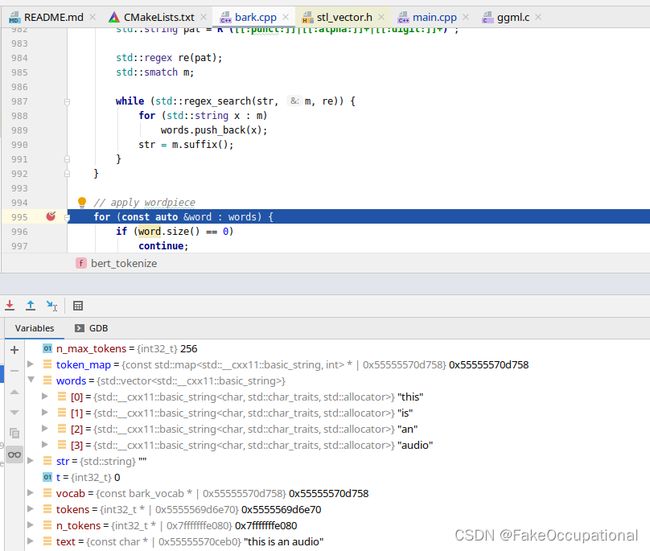
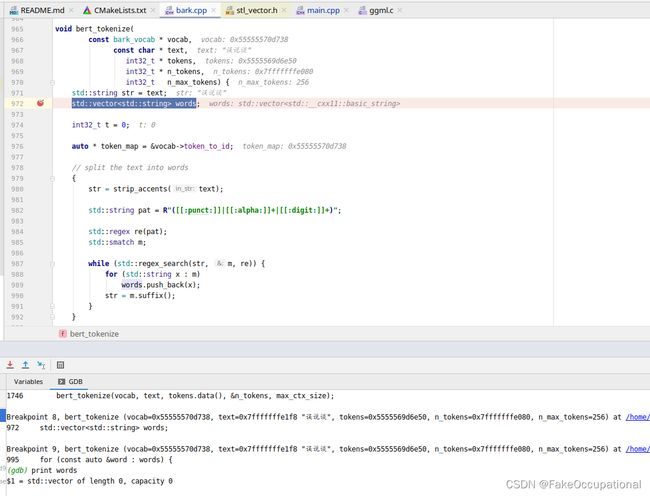
简单修改与运行
struct bark_params {
int32_t n_threads = std::min(4, (int32_t) std::thread::hardware_concurrency());
std::string prompt = "你 好";
std::string model_path = "./bark.cpp/ggml_weights";
std::string dest_wav_path = "output.wav";
int32_t seed = 0;
};
{
str = strip_accents(text);
std::istringstream iss(str);
std::vector<std::string> words;
do {
std::string word;
iss >> word;
words.push_back(word);
} while (iss);
std::cout << "分词结果:" << std::endl;
for (const auto& word : words) {
std::cout << word << std::endl;
}
}
- ps:这样就能成功运行了,但是,不知道为什么中文推理用的内存比英文多,还有这个分不能通过手动空格实现(即使空格也无法运行,因为许多词没在词表中,还需要参考一下bert的分词过程。)









